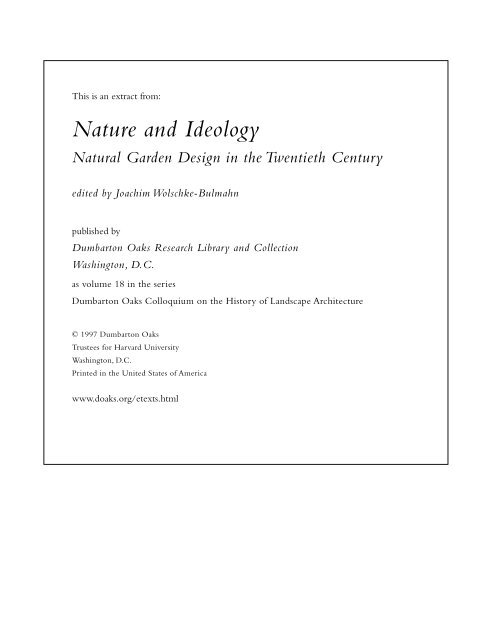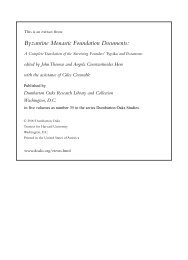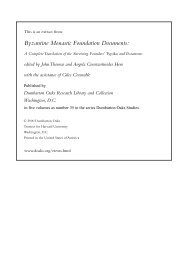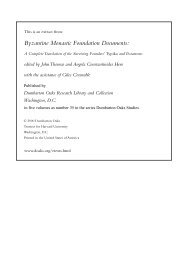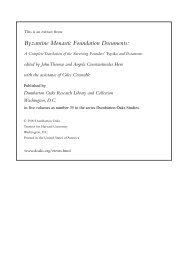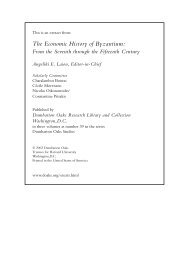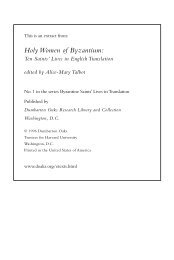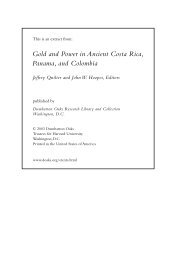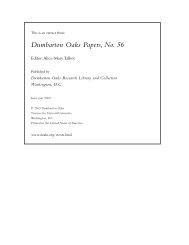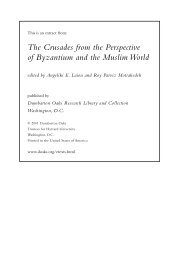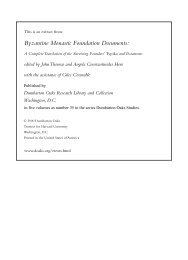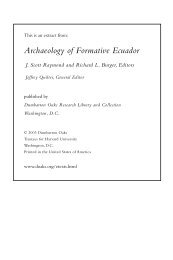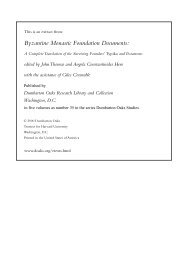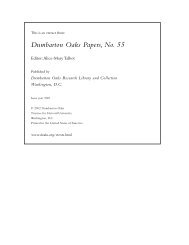Nature and Ideology: Natural Garden Design in ... - Dumbarton Oaks
Nature and Ideology: Natural Garden Design in ... - Dumbarton Oaks
Nature and Ideology: Natural Garden Design in ... - Dumbarton Oaks
Create successful ePaper yourself
Turn your PDF publications into a flip-book with our unique Google optimized e-Paper software.
This is an extract from:<br />
<strong>Nature</strong> <strong>and</strong> <strong>Ideology</strong><br />
<strong>Natural</strong> <strong>Garden</strong> <strong>Design</strong> <strong>in</strong> the Twentieth Century<br />
edited by Joachim Wolschke-Bulmahn<br />
published by<br />
<strong>Dumbarton</strong> <strong>Oaks</strong> Research Library <strong>and</strong> Collection<br />
Wash<strong>in</strong>gton, D.C.<br />
as volume 18 <strong>in</strong> the series<br />
<strong>Dumbarton</strong> <strong>Oaks</strong> Colloquium on the History of L<strong>and</strong>scape Architecture<br />
© 1997 <strong>Dumbarton</strong> <strong>Oaks</strong><br />
Trustees for Harvard University<br />
Wash<strong>in</strong>gton, D.C.<br />
Pr<strong>in</strong>ted <strong>in</strong> the United States of America<br />
www.doaks.org/etexts.html
The Nationalization of <strong>Nature</strong> <strong>and</strong><br />
the <strong>Natural</strong>ization of the German Nation:<br />
“Teutonic” Trends <strong>in</strong> Early Twentieth-Century<br />
L<strong>and</strong>scape <strong>Design</strong><br />
JOACHIM WOLSCHKE-BULMAHN<br />
This paper deals with the issue “<strong>Nature</strong> <strong>and</strong> <strong>Ideology</strong>” <strong>in</strong> the context of trends <strong>in</strong> German<br />
l<strong>and</strong>scape design dur<strong>in</strong>g the early twentieth century. The design of gardens <strong>and</strong> l<strong>and</strong>scapes<br />
is often considered to be an <strong>in</strong>nocuous, nonpolitical task free of ideology. One of the purposes of<br />
this study is to demonstrate the sometimes highly political <strong>and</strong> ideological character of this task<br />
<strong>and</strong> of l<strong>and</strong>scape architecture as a discipl<strong>in</strong>e. The ideological character of German l<strong>and</strong>scape<br />
design <strong>in</strong> the early twentieth century can be most clearly elucidated us<strong>in</strong>g examples of natural<br />
garden <strong>and</strong> l<strong>and</strong>scape design, show<strong>in</strong>g how a group of German l<strong>and</strong>scape architects fostered<br />
nationalism <strong>and</strong> racist ideas about society <strong>and</strong> fought an <strong>in</strong>ternational orientation with their<br />
concepts of natural garden design that were developed dur<strong>in</strong>g the early twentieth century. These<br />
concepts were <strong>in</strong>fluenced by particular ideas about the German nation <strong>and</strong> the German people<br />
<strong>and</strong> their alleged specific relationship to nature that arose <strong>in</strong> the n<strong>in</strong>eteenth century.<br />
The first part of this paper focuses on the development of such n<strong>in</strong>eteenth-century ideas<br />
about the assumed relationship between nature <strong>and</strong> the German people. These ideas <strong>and</strong> their<br />
underly<strong>in</strong>g ideology <strong>in</strong>fluenced l<strong>and</strong>scape design <strong>in</strong> the changed political <strong>and</strong> social conditions of<br />
early twentieth-century Germany. The second part illustrates how such ideas <strong>in</strong>fluenced concepts<br />
of natural l<strong>and</strong>scape design <strong>and</strong> discusses three specific sites <strong>in</strong> northern Germany: two<br />
cemeteries, the Place of the Ancestors Hilligenloh (Ahnenstätte Hilligenloh) (Fig. 1) <strong>and</strong> the<br />
Place of the Ancestors Seelenfeld (Ahnenstätte Seelenfeld) (Fig. 2); <strong>and</strong> the Grove of the Saxons<br />
(Sachsenha<strong>in</strong>), a gather<strong>in</strong>g place for He<strong>in</strong>rich Himmler’s SS near Verden on the river Aller (Fig.<br />
3). The Grove of the Saxons was designed <strong>in</strong> 1935, <strong>and</strong> the Place of the Ancestors Seelenfeld<br />
around 1930, shortly before the takeover by the Nazis; the exact date of the open<strong>in</strong>g of the<br />
I want to thank L<strong>in</strong>da Safran, of the Catholic University of America, for discuss<strong>in</strong>g several versions of this text<br />
with me.<br />
187
JOACHIM WOLSCHKE-BULMAHN<br />
1. Entrance to the Place of the Ancestors Hilligenloh <strong>in</strong> 1930; <strong>in</strong> the background,<br />
the mortuary designed like an ancient Germanic barrow<br />
188<br />
2. View from the Place of the Ancestors Seelenfeld through the entrance gate onto the<br />
surround<strong>in</strong>g rural l<strong>and</strong>scape, 1985; the use of boulders rem<strong>in</strong>ds the visitor of ancient Germanic<br />
tradition
“TEUTONIC” TRENDS<br />
3. Article about He<strong>in</strong>rich Himmler’s Grove of the Saxons published <strong>in</strong> 1935 <strong>in</strong> the SS weekly,<br />
Das Schwarze Korps (photo: Harvard College Library)<br />
189
JOACHIM WOLSCHKE-BULMAHN<br />
Hilligenloh cemetery is unknown but may also be around 1930. The cemeteries are situated near<br />
the villages of Hilligenloh <strong>and</strong> Seelenfeld. 1 They were used by the German People’s Parish<br />
(Deutschvolk-Geme<strong>in</strong>de), an organization that had close ties to the Tannenberg League<br />
(Tannenbergbund), a group founded by the famous World War I general Erich Ludendorff (1865–<br />
1937). The members of this group left the Christian church <strong>and</strong> looked for a truly Germanic<br />
religion. Because they were no longer members of the Christian church, they needed their own<br />
burial places. All three sites functioned as places of commemoration <strong>and</strong> had highly symbolic <strong>and</strong><br />
ideological mean<strong>in</strong>gs. This study shows how these open spaces could manifest this symbolic<br />
mean<strong>in</strong>g <strong>and</strong> how their naturalistic l<strong>and</strong>scape design helped to transmit particular ideas about<br />
race, 2 nation, nature, <strong>and</strong> German history to their users.<br />
L<strong>and</strong>scape <strong>Design</strong> <strong>and</strong> the Search for National Identity<br />
<strong>in</strong> the N<strong>in</strong>eteenth <strong>and</strong> Early Twentieth Centuries<br />
To underst<strong>and</strong> the significance that concepts of natural garden <strong>and</strong> l<strong>and</strong>scape design ga<strong>in</strong>ed<br />
<strong>in</strong> Germany dur<strong>in</strong>g the early twentieth century <strong>and</strong> to underst<strong>and</strong> the design of the Grove of the<br />
Saxons <strong>and</strong> the cemeteries of Seelenfeld <strong>and</strong> Hilligenloh, it is necessary to discuss the search for<br />
a Germanic, a “truly” Teutonic, history with<strong>in</strong> conservative <strong>and</strong> reactionary groups of late n<strong>in</strong>eteenth-<br />
<strong>and</strong> early twentieth-century German society. 3 The search for national identity ga<strong>in</strong>ed<br />
momentum, at least <strong>in</strong> Europe, dur<strong>in</strong>g the eighteenth <strong>and</strong> n<strong>in</strong>eteenth centuries. In Germany this<br />
search also led to a closer look at nature. The goal was to f<strong>in</strong>d particular natural sett<strong>in</strong>gs that could<br />
help to dist<strong>in</strong>guish German nature <strong>and</strong> l<strong>and</strong>scapes from the natural environments of other nations<br />
<strong>and</strong> thus be identified as “truly” Germanic. Accord<strong>in</strong>g to Johann Gottfried von Herder<br />
(1744–1803), a “nation is called a people because it is first of all through nature.” 4 Ideologically<br />
this meant that a people then can be called a nation when it can be derived from nature. The<br />
search for national identity “therefore corresponded also with a very specific aesthetic of nature.<br />
The nationalization of history corresponded with a nationalization of nature.” 5 <strong>Nature</strong> became<br />
def<strong>in</strong>ed <strong>in</strong> national terms.<br />
Evidence of national identity was sought not <strong>in</strong> the Middle Ages, when the formation of<br />
nations began, but <strong>in</strong> prehistoric times. The ancient Germanic tribes stood for “truly” Teutonic<br />
1 The village of Hilligenloh is situated near the town of Hude, between the cities of Oldenburg <strong>and</strong> Bremen;<br />
Seelenfeld is a village near the river Weser between the cities of M<strong>in</strong>den <strong>and</strong> Nienburg.<br />
2 I refer <strong>in</strong> the follow<strong>in</strong>g to terms such as race, people, <strong>and</strong> nation. It should be mentioned that these terms were not<br />
used <strong>in</strong> an unambiguously def<strong>in</strong>ed way but quite often <strong>in</strong>terchangeably. I consider race a social construct. Compare<br />
Stephen Jay Gould’s rejection of the term race as “an outmoded approach to the general problem of differentiation with<strong>in</strong><br />
a species . . . Geographic variability, not race, is self-evident. No one can deny that Homo sapiens is a strongly differentiated<br />
species . . . But the fact of variability does not require the designation of races. There are better ways to study human<br />
differences” (S. J. Gould, Ever s<strong>in</strong>ce Darw<strong>in</strong>: Reflections <strong>in</strong> <strong>Natural</strong> History, New York, 1979, reissued 1992, 231 f ).<br />
3 See <strong>in</strong> more detail Jost Herm<strong>and</strong>, Old Dreams of a New Reich: Volkish Utopias <strong>and</strong> National Socialism, trans. P.<br />
Levesque <strong>in</strong> collaboration with S. Soldovieri, Bloom<strong>in</strong>gton, Ind., 1992.<br />
4 W. Lipp, Natur, Geschichte, Denkmal: Zur Entstehung des Denkmalbewußtse<strong>in</strong>s der bürgerlichen Gesellschaft, Frankfurt<br />
<strong>and</strong> New York, 1987, 264.<br />
5 Ibid.<br />
190
“TEUTONIC” TRENDS<br />
4. Illustration from Friedrich Ludwig von Sckell’s book Beiträge zur bildenden<br />
Gartenkunst für angehende Gartenkünstler und Gartenliebhaber, Munich, 1818<br />
(photo: <strong>Dumbarton</strong> <strong>Oaks</strong>)<br />
traditions. Beg<strong>in</strong>n<strong>in</strong>g with Roman <strong>in</strong>fluence some two thous<strong>and</strong> years ago, Germanic culture<br />
<strong>and</strong> race s<strong>in</strong>ce then were considered to have been weakened <strong>and</strong> <strong>in</strong>fluenced negatively by foreign<br />
peoples or races. German culture therefore had to go back to those times of alleged racial purity.<br />
Ideas about nature <strong>and</strong> the history of the nation became <strong>in</strong>tertw<strong>in</strong>ed <strong>in</strong> the th<strong>in</strong>k<strong>in</strong>g of the<br />
people who wanted to prove the superiority of the Germanic people. <strong>Nature</strong> <strong>and</strong> history melted<br />
together; the Teutonic people were seen as liv<strong>in</strong>g <strong>in</strong> close harmony with nature.<br />
Related ideas also <strong>in</strong>fluenced garden design. Herder <strong>and</strong> other German <strong>in</strong>tellectuals dissem<strong>in</strong>ated<br />
the idea of an organic unity between l<strong>and</strong>scape <strong>and</strong> German history. In this sense, <strong>in</strong><br />
1818 the garden artist Friedrich Ludwig von Sckell (1750–1823), <strong>in</strong> his famous book Contributions<br />
to an Instructive <strong>Garden</strong> Art for Incipient <strong>Garden</strong> Artists <strong>and</strong> <strong>Garden</strong> Enthusiasts (Beiträge zur<br />
bildenden Gartenkunst für angehende Gartenkünstler und Gartenliebhaber), called for the use of “patriotic<br />
species” of trees <strong>and</strong> shrubs for particular places, 6 “for plant<strong>in</strong>gs of ‘patriotic character,’” for<br />
“simplicity,” <strong>and</strong> for “patriotic pictures” 7 (Fig. 4).<br />
Similarly, Alex<strong>and</strong>er von Humboldt (1769–1859) <strong>in</strong>fluenced later concepts of natural garden<br />
design. In his Ideas for a Physiognomy of Plants (Ideen zu e<strong>in</strong>er Physiognomik der Gewächse),<br />
published <strong>in</strong> 1806, Humboldt referred to “patriotic plant characters” (“vaterländische<br />
Pflanzengestalten”) 8 <strong>and</strong> addressed the decisive impact exercised by the vegetation of a country<br />
on the development of <strong>in</strong>dividual cultures. Accord<strong>in</strong>g to Humboldt, “the knowledge of the<br />
6 Cf. F. L. von Sckell, Beiträge zur bildenden Gartenkunst für angehende Gartenkünstler und Gartenliebhaber, repr<strong>in</strong>t of<br />
2nd ed., 1825, Worms, 1982, 197; see also pp. 130 <strong>and</strong> 226.<br />
7 Cf. Lipp, Natur, Geschichte, Denkmal, 264.<br />
8 A. von Humboldt, Ideen zu e<strong>in</strong>er Physiognomik der Gewächse, Tüb<strong>in</strong>gen, 1806, 14.<br />
191
JOACHIM WOLSCHKE-BULMAHN<br />
natural character of different regions of the earth [is] most <strong>in</strong>timately connected with the history<br />
of the human race <strong>and</strong> with its culture.” 9 “The character of a people, gloomy or happy mood of<br />
humank<strong>in</strong>d,” Humboldt argued, was “ma<strong>in</strong>ly dependent on climatic conditions. . . . The poetic<br />
work of the Greeks <strong>and</strong> the harsher s<strong>in</strong>g<strong>in</strong>g of the Nordic primitive people owe their peculiar<br />
character <strong>in</strong> large part to the form of plants <strong>and</strong> animals, to the mounta<strong>in</strong> valleys by which the<br />
poet was surrounded <strong>and</strong> to the air that blew around him.” 10<br />
Thus <strong>in</strong> Humboldt’s philosophy the outer appearance of plants, their physiognomy, ga<strong>in</strong>ed<br />
considerable importance; he assumed that it could <strong>in</strong>fluence even the character of a people.<br />
Humboldt’s ideas about the physiognomy of plants later greatly <strong>in</strong>fluenced Willy Lange’s (1864–<br />
1941) concept of natural garden design, which was based on the doctr<strong>in</strong>e of plant physiognomy.<br />
11 Lange was the most important promoter of natural garden design <strong>in</strong> Germany <strong>in</strong> the<br />
early twentieth century. For him natural garden design was determ<strong>in</strong>ed not so much by ecology<br />
but by the physiognomical appearance of plants. In his concepts of natural garden design, one<br />
goal was to use foreign plants that physiognomically fit with the <strong>in</strong>digenous plant associations <strong>in</strong><br />
order to heighten <strong>and</strong> improve the beauty of nature by artistic means. 12<br />
Before Lange’s time, around the turn of the eighteenth to the n<strong>in</strong>eteenth century, the<br />
search for national identity was more-or-less progressive <strong>in</strong> character. The long<strong>in</strong>g for national<br />
unification was the ma<strong>in</strong> driv<strong>in</strong>g force, not, as <strong>in</strong> the early twentieth century, the claim for world<br />
power. Intellectuals such as Justus Möser (1720–94) “envisioned a state <strong>in</strong> which each <strong>in</strong>dividual<br />
would feel responsible for the work<strong>in</strong>gs of the whole, everyone would feel volkish, Germanic, or<br />
Teutonic <strong>and</strong> the fatherl<strong>and</strong> would become the object of universal love—<strong>in</strong> short, one with<br />
which the common ‘peasant’ <strong>and</strong> the common ‘artisan’ could also identify. Therefore, their political<br />
utopia was not a constitutional monarchy but a German republic, a fact reflected <strong>in</strong> the<br />
way the terms ‘patriotism’ <strong>and</strong> ‘republicanism’ became virtual synonyms.” 13<br />
Nevertheless, also at that time the idea of the nation was somewhat ambivalent <strong>in</strong> character.<br />
Reservations about or even hostility toward other peoples were <strong>in</strong>herent elements of nationalism<br />
from the very beg<strong>in</strong>n<strong>in</strong>g. Johann Gottlieb Fichte’s (1762–1814) Addresses to the German Nation<br />
(Reden an die deutsche Nation), 14 for example, presented the Germans as a people “whose natural<br />
disposition toward freedom dates back to prehistoric times, when they had been a pure <strong>and</strong><br />
unta<strong>in</strong>ted race, a time before the <strong>in</strong>fluence of foreigners <strong>and</strong> the <strong>in</strong>troduction of class division.” 15<br />
This ambivalent character of the idea of the German nation later turned out to promote reactionary<br />
rather than democratic ideas about the political <strong>and</strong> social organization of the German<br />
people. In particular, after the failed revolution of 1848 <strong>and</strong> then later with the establishment of<br />
9 Ibid., 13.<br />
10 Ibid.<br />
11 See <strong>in</strong> more detail G. Grön<strong>in</strong>g <strong>and</strong> J. Wolschke-Bulmahn, “Changes <strong>in</strong> the Philosophy of <strong>Garden</strong> Architecture<br />
<strong>in</strong> the 20th Century <strong>and</strong> Their Impact upon the Social <strong>and</strong> Spatial Environment,” Journal of <strong>Garden</strong> History 9, 2 (1989),<br />
53–70, especially 55.<br />
12 Cf. ibid.<br />
13 Herm<strong>and</strong>, Old Dreams, 10.<br />
14 See, for example, J. G. Fichte, Addresses to the German Nation, Westport, Conn., 1979.<br />
15 Herm<strong>and</strong>, Old Dreams, 14.<br />
192
“TEUTONIC” TRENDS<br />
5. Frontispiece of Willy Pastor’s book<br />
Aus germanischer Vorzeit, Berl<strong>in</strong>, 1907<br />
the German Reich <strong>in</strong> 1871, the nationalization of all spheres of life became more <strong>and</strong> more<br />
reactionary <strong>in</strong> character. Teutonic history was more <strong>and</strong> more aggressively contrasted as superior<br />
to the cultural traditions of other peoples.<br />
Thus one can recognize at the turn of the n<strong>in</strong>eteenth to the twentieth century an <strong>in</strong>creas<strong>in</strong>g<br />
search for the heritage of the German people <strong>in</strong> order to substantiate the claim of the German<br />
Reich for world power. Particular attention was paid, with regard to a Germanic heritage, to a<br />
specific relationship of the German people to nature <strong>and</strong> l<strong>and</strong>scape. One should mention, for<br />
example, the art historian Josef Strzygowski (1862–1941) <strong>and</strong> the writer Willy Pastor (1867–<br />
1933). Pastor, Strzygowski, <strong>and</strong> also the l<strong>and</strong>scape architect Willy Lange belonged to the same<br />
generation, born <strong>in</strong> the 1860s. Pastor discussed ideas about the history of the ancient Germanic<br />
tribes <strong>in</strong> numerous publications <strong>and</strong>, for example, tried to correct the image “of the often defamed<br />
‘barbaric’ early history of Germania” 16 <strong>in</strong> his one-sided book From Germanic Prehistoric<br />
Times (Aus germanischer Vorzeit) (Fig. 5), published <strong>in</strong> 1907. Pastor’s works <strong>and</strong> numerous other<br />
publications were <strong>in</strong>tended to prove the outst<strong>and</strong><strong>in</strong>gly high cultural level of the prehistoric Germanic<br />
tribes. For Pastor there was no doubt that “as well as the decisive waves of people, the<br />
decisive waves of culture came from the North.” 17 He believed <strong>in</strong>, as he called it, the “doctr<strong>in</strong>e of<br />
the Nordic orig<strong>in</strong> of any culture.” 18 Similarly, Strzygowski compla<strong>in</strong>ed that the high level of<br />
16 W. Pastor, Aus germanischer Vorzeit, Berl<strong>in</strong>, 1907, “Vorwort.”<br />
17 Ibid., 11.<br />
18 W. Pastor, Die Erde <strong>in</strong> der Zeit des Menschen: Versuch e<strong>in</strong>er naturwissenschaftlichen Kunstgeschichte, Jena <strong>and</strong> Leipzig,<br />
1904, 189.<br />
193
JOACHIM WOLSCHKE-BULMAHN<br />
6. Ancient barrow <strong>in</strong> the region of<br />
Mecklenburg (from W. Lendholt,<br />
“Vorgeschichtliche L<strong>and</strong>schaftswerte,”<br />
Gartenkunst 50 [1937], 23)<br />
Nordic art <strong>and</strong> the specific relationship of the Nordic people to nature <strong>and</strong> l<strong>and</strong>scape had been<br />
hitherto ignored <strong>in</strong> the field of art history. 19<br />
It was difficult for <strong>in</strong>tellectuals such as Pastor, Strzygowski, <strong>and</strong> Lange to substantiate assertions<br />
of the “Nordic orig<strong>in</strong> of any culture” by referr<strong>in</strong>g to cultural achievements of the Germanic<br />
people that were comparable to those of the Greeks <strong>and</strong> the Romans <strong>in</strong>, for example,<br />
architecture <strong>and</strong> the arts. One approach to substantiat<strong>in</strong>g such assertions was to subsume the<br />
cultural achievements of other contemporary peoples. This is made clear by Pastor’s statement<br />
that the ancient Greek temples would give evidence of Germanic spirit. In 1904 Pastor wrote<br />
about these temples: “This simple gable build<strong>in</strong>g, this straightforward <strong>and</strong> simple art, that is not<br />
at all Roman character, that is totally Germanic spirit.” 20 Similarly, He<strong>in</strong>rich Friedrich Wiepk<strong>in</strong>g-<br />
Jürgensmann (1891–1973), one of the lead<strong>in</strong>g Nazi l<strong>and</strong>scape architects, stated <strong>in</strong> 1936 about<br />
Germanic megalithic tombs on the isl<strong>and</strong> of Rügen <strong>and</strong> their harmonic <strong>in</strong>tegration <strong>in</strong>to the<br />
l<strong>and</strong>scape: “When I reached the top of the tomb I suddenly knew: it is the same spirit that has<br />
19 See, for example, J. Strzygowski, Die L<strong>and</strong>schaft <strong>in</strong> der nordischen Kunst, Bibliothek der Kunstgeschichte 17,<br />
Leipzig, 1922, 3; idem, Der Norden <strong>in</strong> der bildenden Kunst Westeuropas: Heidnisches und Christliches um das Jahr 1000, Vienna,<br />
1926, 7.<br />
20 Pastor, Die Erde, 128.<br />
194
“TEUTONIC” TRENDS<br />
built the Greek master build<strong>in</strong>gs at the Mediterranean Sea! A long<strong>in</strong>g was fulfilled!” 21 An illustration<br />
of such a tomb as it was seen by Wiepk<strong>in</strong>g may visualize the ignorance of his statement (Fig.<br />
6). Wiepk<strong>in</strong>g was referr<strong>in</strong>g to such a simple mound, a Germanic barrow covered with earth, <strong>and</strong><br />
equated it with ancient Greek architecture.<br />
Another way of try<strong>in</strong>g to prove the Germanic cultural superiority was not so much to stress<br />
the cultural achievements of the ancient Germanic tribes, but to refer to a specific Germanic<br />
relationship to nature. Many contemporary nations “used their native l<strong>and</strong>scapes as a means of<br />
self-representation, but nature was especially important <strong>in</strong> the def<strong>in</strong>ition of German nationalism.”<br />
22 Willy Pastor deduced such a close relationship from the impact of the glacial period on<br />
man <strong>and</strong> nature. Accord<strong>in</strong>g to Pastor, the glaciers<br />
not only <strong>in</strong>fluenced the racial breed of humans, but also selected trees <strong>and</strong> plants. The<br />
woods, which moved together with the people to the North, looked different from one<br />
glacial period to the next. And the European primeval forest, which f<strong>in</strong>ally evolved as the<br />
strongest out of this severe school, was no less of Germanic, Nordic race as the people it was<br />
follow<strong>in</strong>g. . . . This was the last great separation. The last, <strong>and</strong> the most important. Now,<br />
f<strong>in</strong>ally, the planet succeeded <strong>in</strong> creat<strong>in</strong>g the Germanic people, a race that should prove<br />
physically <strong>and</strong> spiritually capable of guid<strong>in</strong>g the fortunes of the human race. 23<br />
Such ideas of Germ<strong>and</strong>om as the cultural bearer of humank<strong>in</strong>d are also clearly reflected <strong>in</strong><br />
publications of the l<strong>and</strong>scape architect Willy Lange about natural garden design. Lange <strong>and</strong> Pastor<br />
were friends, <strong>and</strong> they referred to each other <strong>in</strong> their publications time <strong>and</strong> aga<strong>in</strong>. 24 Lange was<br />
professor of garden design <strong>in</strong> Berl<strong>in</strong> <strong>and</strong> one of the most significant garden theorists <strong>in</strong> early<br />
twentieth-century Germany. In his publications Lange claimed that the German nature garden<br />
was the highest form of garden art <strong>and</strong> proof that Germany would be the cultural bearer of<br />
humank<strong>in</strong>d <strong>in</strong> the field of garden art. 25 In 1905 he stated: “The highest development of garden<br />
design is consequently based on the scientific Weltanschauung of our times <strong>and</strong> is reflected <strong>in</strong> the<br />
artistic nature garden.” 26 Some years later he said about natural garden design: “History will call<br />
this new stage of garden style, which is firmly based on its precursors, the stage of the German<br />
garden style. Germany has chosen to lend its name to this style <strong>in</strong> the history of gardens <strong>and</strong> to<br />
become once aga<strong>in</strong> ‘an improver of the world’” 27 (Fig. 7).<br />
21 H. Fr. Wiepk<strong>in</strong>g-Jürgensmann, “Germanische Ahnenl<strong>and</strong>schaften auf der Insel Rügen,” Gartenkunst 49 (1936),<br />
137.<br />
22 G. L. Mosse, Fallen Soldiers: Reshap<strong>in</strong>g the Memory of the World Wars, New York <strong>and</strong> Oxford, 1992, 87.<br />
23 Pastor, Aus germanischer Vorzeit, 52 f.<br />
24 See, for example, W. Pastor, Deutsche Urzeit: Grundlagen der germanischen Geschichte, Weimar, n.d., 283.<br />
25 I cannot discuss Lange’s concept of natural garden design <strong>in</strong> detail here. That has been done by Gert Grön<strong>in</strong>g<br />
<strong>and</strong> myself <strong>in</strong> several articles. See, for example, Grön<strong>in</strong>g <strong>and</strong> Wolschke-Bulmahn, “Changes <strong>in</strong> the Philosophy of <strong>Garden</strong><br />
Architecture”; J. Wolschke-Bulmahn <strong>and</strong> G. Grön<strong>in</strong>g, “The <strong>Ideology</strong> of the <strong>Nature</strong> <strong>Garden</strong>: Nationalistic Trends <strong>in</strong><br />
<strong>Garden</strong> <strong>Design</strong> <strong>in</strong> Germany dur<strong>in</strong>g the Early Twentieth Century,” Journal of <strong>Garden</strong> History 12, 1 (1992), 73–80; J.<br />
Wolschke-Bulmahn, “The ‘Wild <strong>Garden</strong>’ <strong>and</strong> the ‘<strong>Nature</strong> <strong>Garden</strong>’: Aspects of the <strong>Garden</strong> <strong>Ideology</strong> of William Rob<strong>in</strong>son<br />
<strong>and</strong> Willy Lange,” Journal of <strong>Garden</strong> History 12, 3 (1992), 183–206.<br />
26 W. Lange, “Me<strong>in</strong>e Anschauungen über die Gartengestaltung unserer Zeit,” Gartenkunst 7 (1905), 114.<br />
27 W. Lange, Gartenbilder, Leipzig, 1922, 27.<br />
195
JOACHIM WOLSCHKE-BULMAHN<br />
7. Motif from Willy Lange’s own garden,<br />
designed <strong>in</strong> the natural style<br />
(from W. Lange, Gartengestaltung der<br />
Neuzeit, Leipzig, 1909, pl. XVI)<br />
Lange’s plea for the nature garden as the highpo<strong>in</strong>t of evolution <strong>in</strong> garden design was<br />
probably taken from art historians <strong>and</strong> theorists such as Alois Riegl, who followed the idea that<br />
the use of geometrical styles <strong>in</strong> architecture <strong>and</strong> other art forms would be a sign of a low cultural<br />
level. Thus Riegl wrote <strong>in</strong> his book Stilfragen: “The geometrical style accord<strong>in</strong>g to the highest<br />
laws of symmetry <strong>and</strong> rhythm is from the po<strong>in</strong>t of view of lawfulness the most perfect one. But<br />
<strong>in</strong> our appreciation it is the lowest one, <strong>and</strong> the evolution of arts also has shown that this style was<br />
mostly characteristic of nations when they still existed on a relatively low cultural level.” 28<br />
The difficulty of substantiat<strong>in</strong>g the superior cultural position of the Germanic tribes by<br />
referr<strong>in</strong>g to architecture <strong>and</strong> works of art led conservative <strong>in</strong>tellectuals to argue for a close <strong>and</strong><br />
harmonic relationship of the Germanic people to nature. The outst<strong>and</strong><strong>in</strong>g character of Nordic<br />
culture was not seen <strong>in</strong> a conscious change of nature <strong>in</strong>to cultural artifacts, but <strong>in</strong> adaptation of<br />
28 A. Riegl, Stilfragen: Grundlegungen zu e<strong>in</strong>er Geschichte der Ornamentik, Munich, 1985, repr<strong>in</strong>t of the 1893 ed., 3;<br />
the <strong>in</strong>fluence of Riegl may be <strong>in</strong>dicated by W. Worr<strong>in</strong>ger’s use of this passage <strong>in</strong> his book Abstraktion und E<strong>in</strong>fühlung: E<strong>in</strong><br />
Beitrag zur Stilpsychologie, 8th ed., Munich, 1919, 22.<br />
196
“TEUTONIC” TRENDS<br />
8. Germanic burial place <strong>in</strong> the prov<strong>in</strong>ce of Hannover<br />
(from W. Pastor, Aus germanischer Vorzeit, Berl<strong>in</strong>, 1907, pl. VI)<br />
culture to nature. Cultural history was idealized to natural history, as <strong>in</strong>dicated <strong>in</strong> the subtitle of<br />
Pastor’s book, The Earth <strong>in</strong> the Time of Man (Die Erde <strong>in</strong> der Zeit des Menschen): Attempt at a <strong>Natural</strong><br />
Scientific History of Culture (Versuch e<strong>in</strong>er naturwissenschaftlichen Kulturgeschichte). <strong>Nature</strong>, the German<br />
primeval forest, Pastor argued, “had contributed best to create the specific race that is today<br />
the most important element of our planet.” 29<br />
The primeval forest, with its clear<strong>in</strong>gs made by the early Germanic tribes for their settlements,<br />
ga<strong>in</strong>ed a great ideological significance. Pastor published a collection of essays entitled<br />
Clear<strong>in</strong>gs (Lichtungen); his book The Earth <strong>in</strong> the Time of Man also conta<strong>in</strong>s a chapter entitled<br />
“Clear<strong>in</strong>gs,” <strong>in</strong> which he quotes Tacitus’ description “of the first clear<strong>in</strong>gs <strong>in</strong> the Germanic<br />
primeval forests.” 30 The concept of the clear<strong>in</strong>g, <strong>in</strong>clud<strong>in</strong>g a council r<strong>in</strong>g, was later realized with<br />
Himmler’s Grove of the Saxons. The American l<strong>and</strong>scape architect Jens Jensen had close contact<br />
with German colleagues <strong>and</strong> was <strong>in</strong>fluenced by such ideas about Germanic <strong>and</strong> Nordic history.<br />
His ideas about Clear<strong>in</strong>gs 31 <strong>and</strong> council r<strong>in</strong>gs may have been <strong>in</strong>spired by the works of Pastor <strong>and</strong><br />
related authors. He himself stated <strong>in</strong> his 1938 contribution to the International Horticulture<br />
Conference <strong>in</strong> Berl<strong>in</strong>: “The Nordic, or if you please, Germanic m<strong>in</strong>d, is not imbued with formalism<br />
of any k<strong>in</strong>d. To him it is an affected th<strong>in</strong>g. It does not speak the truth as the truth should<br />
29 Pastor, Deutsche Urzeit, 7.<br />
30 Pastor, Die Erde, 190.<br />
31 See, for example, J. Jensen, The Clear<strong>in</strong>g: “A Way of Life,” Chicago, ca. 1949.<br />
197
JOACHIM WOLSCHKE-BULMAHN<br />
be told by an <strong>in</strong>tellectual people. To him it is foreign. One of the most fasc<strong>in</strong>at<strong>in</strong>g th<strong>in</strong>gs to the<br />
Nordic m<strong>in</strong>d is the fire, the beg<strong>in</strong>n<strong>in</strong>g of civilization. I love the fire <strong>and</strong> I love the council r<strong>in</strong>g,<br />
the first of which I constructed back <strong>in</strong> 1890 <strong>in</strong> my own garden.” 32<br />
Pastor glorified the Germanic feel<strong>in</strong>g for l<strong>and</strong>scape beauty as reflected <strong>in</strong> holy places, monuments,<br />
<strong>and</strong> graves <strong>in</strong> the follow<strong>in</strong>g way: “The works seem to grow out of l<strong>and</strong>scape pictures. Let<br />
us th<strong>in</strong>k of a massive Dolmen-build<strong>in</strong>g, then it is the same as if our view would w<strong>and</strong>er over a<br />
pla<strong>in</strong> to the open Nordic gray sea. The Rundl<strong>in</strong>ge <strong>and</strong> Bautaste<strong>in</strong>e fit excellently <strong>in</strong> the picture of<br />
rough coast l<strong>and</strong>scapes with steep cliffs, rocky coasts, defiant erratic blocks; so well that their<br />
formation becomes someth<strong>in</strong>g self-evident with regard to natural history.” 33<br />
The impression of a particularly close relation of such prehistoric Germanic holy sites <strong>and</strong><br />
burial places to nature was probably strengthened by the fact that these architectural rema<strong>in</strong>s<br />
were made of natural material that was only slightly shaped, the “erratic blocks” that <strong>in</strong> the<br />
course of the glacial period were brought to central Europe (Fig. 8). The visual character of such<br />
tombs <strong>and</strong> monuments did not considerably st<strong>and</strong> out <strong>in</strong> the l<strong>and</strong>scape. It therefore was quite<br />
easy to <strong>in</strong>terpret them as well-<strong>in</strong>tegrated <strong>in</strong>to the l<strong>and</strong>scape <strong>and</strong> as expressions of an outst<strong>and</strong><strong>in</strong>g<br />
Germanic feel<strong>in</strong>g for l<strong>and</strong>scape beauty. In this sense Pastor commented on them: “Any excellent<br />
architecture grows organically out of very specific l<strong>and</strong>scape pictures.” 34 He described the l<strong>and</strong>scape<br />
design of these megalithic tombs as follows: “They become covered with earth, mounds<br />
arch above them, <strong>and</strong> the majestic curve of the mounds reflects aga<strong>in</strong> the monumental character<br />
of this whole culture.” 35 In order to present this history <strong>and</strong> to commemorate it, Pastor proposed<br />
to establish a “Nordic Park.” The park should <strong>in</strong>form about the history of the Germanic race,<br />
beg<strong>in</strong>n<strong>in</strong>g with the late Stone Age, <strong>and</strong>, as Pastor suggested, “a number of megalithic tombs <strong>and</strong><br />
stones [Hünenste<strong>in</strong>e] has to be collected <strong>and</strong> to be set up at various po<strong>in</strong>ts <strong>in</strong> the park.” 36<br />
The Nazi Period <strong>and</strong> L<strong>and</strong>scape <strong>Design</strong><br />
Dur<strong>in</strong>g the time of the Imperial Reich <strong>and</strong> the Weimar Republic, such ideas about a close<br />
relationship of the German people to nature <strong>and</strong> the superiority of the Germans over other<br />
people were <strong>in</strong>fluential, but at the same time counterbalanced by different ideas about society<br />
held by other groups <strong>and</strong> based on democratic ideals. Pastor, Lange, <strong>and</strong> like-m<strong>in</strong>ded writers<br />
therefore never could ga<strong>in</strong> dom<strong>in</strong>at<strong>in</strong>g <strong>in</strong>fluence <strong>in</strong> their related fields, although Lange has to be<br />
acknowledged as one of the most significant garden theorists of his time <strong>in</strong> Germany. This situation<br />
changed with the takeover by National Socialism. Then the search for national identity <strong>in</strong><br />
a Germanic nature reached a new dimension <strong>in</strong> the field of l<strong>and</strong>scape design. 37 Before 1933 one<br />
can f<strong>in</strong>d numerous publications by l<strong>and</strong>scape architects entitled “The German <strong>Garden</strong>” or someth<strong>in</strong>g<br />
similar. 38 There were many different ways to def<strong>in</strong>e German garden art, rang<strong>in</strong>g from more<br />
32 J. Jensen, “Park <strong>and</strong> <strong>Garden</strong> Plann<strong>in</strong>g,” <strong>in</strong> 12. Internationaler Gartenbau-Kongreß Berl<strong>in</strong> 1938, vol. 2, Berl<strong>in</strong>, 1939,<br />
1007.<br />
33 Pastor, Deutsche Urzeit, 25.<br />
34 Ibid., 223.<br />
35 Pastor, Die Erde, 55.<br />
36 Pastor, Deutsche Urzeit, 70.<br />
37 Cf. Wolschke-Bulmahn <strong>and</strong> Grön<strong>in</strong>g, “The <strong>Ideology</strong> of the <strong>Nature</strong> <strong>Garden</strong>.”<br />
38 See, for example, C. Schneider, Deutsche Gartengestaltung und Kunst: Zeit- und Streitfragen, Leipzig, 1904.<br />
198
“TEUTONIC” TRENDS<br />
formal to more <strong>in</strong>formal designs. But dur<strong>in</strong>g the time of National Socialism, natural design<br />
clearly was considered to be the most decisive characteristic of German l<strong>and</strong>scape design, as can<br />
be seen <strong>in</strong> Hans Hasler’s 1939 book German <strong>Garden</strong> Art (Deutsche Gartenkunst), a reception <strong>and</strong><br />
glorification of Willy Lange’s ideas about the nature garden. 39<br />
Ideas about a congenital relationship of the German people to nature had a particular<br />
impact on early twentieth-century l<strong>and</strong>scape design <strong>in</strong> Germany <strong>and</strong> led to the development of<br />
sophisticated concepts of natural gardens. This is reflected most clearly <strong>in</strong> the work <strong>and</strong> publications<br />
of l<strong>and</strong>scape architects such as Willy Lange <strong>and</strong> Alw<strong>in</strong> Seifert (1890–1972). One of the<br />
assumptions underly<strong>in</strong>g their concepts of natural l<strong>and</strong>scape design was that the German people<br />
were closely bound to nature <strong>and</strong> therefore required its appropriately designed cultural environments,<br />
<strong>in</strong>clud<strong>in</strong>g gardens <strong>and</strong> l<strong>and</strong>scapes.<br />
L<strong>and</strong>scape architects tried to prove that ancient Germanic tribes had possessed a genetically<br />
<strong>in</strong>herent “feel<strong>in</strong>g” for l<strong>and</strong>scape beauty, someth<strong>in</strong>g that <strong>in</strong> the course of romanticism developed<br />
<strong>in</strong>to an aesthetic ideal of the upper <strong>and</strong> middle classes. The design of ancient pagan Germanic<br />
barrows <strong>and</strong> gather<strong>in</strong>g places—for example, the use of boulders <strong>and</strong> their situation <strong>in</strong> the l<strong>and</strong>scape—was<br />
studied with particular <strong>in</strong>terest. <strong>Natural</strong> design was praised as truly “Teutonic,” while<br />
formal design was maligned as be<strong>in</strong>g on a lower cultural level <strong>and</strong> characteristic of so-called<br />
“south Alp<strong>in</strong>e races.” Thus, <strong>in</strong> 1927, Willy Lange wrote about the assumed relationship between<br />
natural garden design <strong>and</strong> the Nordic people <strong>and</strong> formal design <strong>and</strong> the Mediterranean people:<br />
The contrasts between the “formal” French <strong>and</strong> the “<strong>in</strong>formal” English garden style<br />
are much more deeply founded, [aris<strong>in</strong>g from] different Weltanschauungen, <strong>and</strong> these aga<strong>in</strong><br />
from the differences between the souls of the two races; because <strong>in</strong> the soul of the race all<br />
feel<strong>in</strong>gs, action, <strong>and</strong> nonaction [Tun und Lassen] are rooted. The French style is the garden<br />
expression of the south-alp<strong>in</strong>e Mediterranean race; the English style germ<strong>in</strong>ates from the<br />
reawakened feel<strong>in</strong>g for one’s race of the north-alp<strong>in</strong>e, the Nordic people. . . . In an unconscious<br />
way the Nordic man “protested” <strong>in</strong> Pückler aga<strong>in</strong>st the un-Nordic spirit <strong>in</strong> garden<br />
life. 40<br />
Lange’s ignorance <strong>and</strong> the nonsense of the idea about a congenital German aff<strong>in</strong>ity to a natural<br />
garden style become obvious when one considers that Lange also had designed formal gardens,<br />
for example, for the Royal Horticultural School Berl<strong>in</strong>-Dahlem (Höhere Gärtnerlehranstalt Berl<strong>in</strong>-<br />
Dahlem) (Fig. 9).<br />
Of particular significance for the promotion of such racist ideas about l<strong>and</strong>scape design was<br />
He<strong>in</strong>rich Friedrich Wiepk<strong>in</strong>g-Jürgensmann. Wiepk<strong>in</strong>g was one of the most <strong>in</strong>fluential l<strong>and</strong>scape<br />
architects <strong>in</strong> twentieth-century Germany. From 1934 until 1945 he held the l<strong>and</strong>scape design<br />
chair at the College of Agriculture (L<strong>and</strong>wirtschaftliche Hochschule) <strong>in</strong> Berl<strong>in</strong>. After the Second<br />
World War he was professor of l<strong>and</strong>scape architecture at the University of Hannover. Wiepk<strong>in</strong>g<br />
was conv<strong>in</strong>ced that, <strong>in</strong> contrast to other peoples, the Germanic people possessed from the very<br />
beg<strong>in</strong>n<strong>in</strong>g an <strong>in</strong>herent congenital feel<strong>in</strong>g for l<strong>and</strong>scape beauty. He tried to prove this by analyz-<br />
39 H. Hasler, Deutsche Gartenkunst, Stuttgart, 1939; Hasler was an ardent admirer <strong>and</strong> follower of Willy Lange.<br />
40 W. Lange, Gartenpläne, Leipzig, 1927, 5.<br />
199
JOACHIM WOLSCHKE-BULMAHN<br />
9. Formal garden at the Royal College for <strong>Garden</strong>ers (Königliche Gärtnerlehranstalt) <strong>in</strong> Berl<strong>in</strong>-Dahlem,<br />
designed by Willy Lange (from K. Schechner, “Me<strong>in</strong>e Studienreise,” Oesterreichische Gartenzeitung 7, 3<br />
[1912], 83)<br />
<strong>in</strong>g the situation of their prehistoric burial places <strong>in</strong> the l<strong>and</strong>scape. German art for him was “not<br />
conceivable without the cult of death <strong>and</strong> veneration of ancestors.” 41 He <strong>in</strong>terpreted the numerous<br />
grave mounds of the ancient Germanic tribes as proof that<br />
they represent the greatest human achievement which is passed down to us of the life<br />
of our ancestors. . . . Where we can f<strong>in</strong>d a grave <strong>in</strong> the Germanic primeval area dat<strong>in</strong>g from<br />
the late Stone Age or Bronze Age, it is always the center of a wonderful, <strong>in</strong> most cases<br />
deeply graded <strong>and</strong> once <strong>in</strong>habited, cultivated <strong>and</strong> designed cultural l<strong>and</strong>scape. At more than<br />
one thous<strong>and</strong> examples [of such sites] <strong>in</strong> Sweden <strong>and</strong> Norway, on the isl<strong>and</strong>s <strong>in</strong> the Baltic<br />
Sea, <strong>in</strong> Denmark, Germany, <strong>and</strong> the Netherl<strong>and</strong>s, we have analyzed these grave mounds<br />
<strong>and</strong> their l<strong>and</strong>scape relationships <strong>and</strong> have diagnosed them by photographs, numerous charts,<br />
<strong>and</strong> by entries on many large-scale maps. Anybody who has once become deeply <strong>in</strong>volved<br />
<strong>in</strong> the high level of our culture dur<strong>in</strong>g the Germanic Bronze Age, who has once grasped the<br />
spirit of the works of art of this period, will easily f<strong>in</strong>d that this period was a heyday of high<br />
culture such as has rarely been reached aga<strong>in</strong>. The grave mounds of those times are masterpieces<br />
of l<strong>and</strong>scape design, documents that require our love <strong>and</strong> our highest veneration.<br />
They give evidence that our people has been deeply connected with the great creation <strong>and</strong><br />
that <strong>in</strong> those earlier days we were part of a comprehensive unit of nature. . . . The grave<br />
mounds do not lie just anywhere <strong>in</strong> the countryside. Rather, they are centers <strong>and</strong> po<strong>in</strong>ts of<br />
experiences of earthly beauty, masterfully chosen <strong>and</strong> designed. 42<br />
41 H. Fr. Wiepk<strong>in</strong>g-Jürgensmann, “Reichsehrenmal Tannenberg,” Gartenschönheit 18 (1937), 421.<br />
42 Ibid., 421 f.<br />
200
“TEUTONIC” TRENDS<br />
This racist idea, held by Wiepk<strong>in</strong>g <strong>and</strong> others, of a specific German feel<strong>in</strong>g for l<strong>and</strong>scape<br />
beauty <strong>and</strong> nature, <strong>and</strong> the search for national identity <strong>and</strong> for l<strong>in</strong>ks from present German society<br />
to the ancient Germanic tribes, had a considerable impact on l<strong>and</strong>scape design dur<strong>in</strong>g National<br />
Socialism. The study of prehistoric Germanic l<strong>and</strong>scapes became an important part of Wiepk<strong>in</strong>g’s<br />
curriculum. Many of his students wrote their master’s theses on related topics. One of these<br />
studies was carried out by Werner Lendholt (1912–80), who later was Wiepk<strong>in</strong>g’s successor at the<br />
University of Hannover. Wiepk<strong>in</strong>g <strong>in</strong>troduced Lendholt’s work <strong>in</strong> 1937 to the readership of the<br />
magaz<strong>in</strong>e Gartenkunst, the most <strong>in</strong>fluential l<strong>and</strong>scape architecture magaz<strong>in</strong>e <strong>in</strong> Germany at that<br />
time, as follows:<br />
Mr. Lendholt had the task of prov<strong>in</strong>g, on the basis of the large-scale map of Hohenzieritz,<br />
that our ancestors already dur<strong>in</strong>g the Bronze Age had a highly developed sense of l<strong>and</strong>scape<br />
beauty <strong>and</strong> that they were already l<strong>and</strong>scape designers. The task of Mr. Lendholt is part of<br />
the <strong>in</strong>vestigation of the entire Ur-Germanic space with regard to these aspects. His work<br />
produced wonderful confirmations. We know now that we possess an ancient culture, <strong>and</strong><br />
we know that the Germanic idea of Midgart does not belong merely to the world of<br />
myths 43 (Fig. 6).<br />
It need only be mentioned here that Lendholt did not have the task of <strong>in</strong>vestigat<strong>in</strong>g whether the<br />
ancestors of the German people “had a highly developed sense of l<strong>and</strong>scape beauty” but “the task<br />
of prov<strong>in</strong>g” it. This serves as one of numerous examples that provide evidence of Wiepk<strong>in</strong>g’s<br />
unscholarly <strong>and</strong> doctr<strong>in</strong>aire way of teach<strong>in</strong>g.<br />
These remarks may suffice to expla<strong>in</strong> the ideological background for the design of the<br />
Grove of the Saxons <strong>and</strong> the Places of the Ancestors at Hilligenloh <strong>and</strong> Seelenfeld, the sites that<br />
are discussed below.<br />
The Places of the Ancestors at Hilligenloh <strong>and</strong> Seelenfeld<br />
The Grove of the Saxons <strong>and</strong> the cemeteries of Hilligenloh <strong>and</strong> Seelenfeld are situated <strong>in</strong><br />
the northern part of Germany: the Sachsenha<strong>in</strong> near Verden on the river Aller, the Seelenfeld<br />
cemetery between M<strong>in</strong>den <strong>and</strong> Nienburg, <strong>and</strong> Hilligenloh near Oldenburg. These regions are<br />
characterized by agricultural use <strong>and</strong> heather l<strong>and</strong>scapes that conta<strong>in</strong> numerous examples of<br />
ancient Germanic burial sites. The cemeteries of Seelenfeld <strong>and</strong> Hilligenloh were laid out around<br />
1930 by members of the so-called Tannenberg League <strong>and</strong> the German People’s Parish, two<br />
volkish organizations which were closely <strong>in</strong>terwoven. The Tannenberg League was founded <strong>in</strong><br />
August 1925 by Erich Ludendorff, a “lead<strong>in</strong>g German general <strong>in</strong> the First World War (<strong>and</strong>) coleader<br />
of the Munich beer hall putsch.” 44 Ludendorff’s Tannenberg League was part of a movement<br />
that “advocated some form of national socialism which was at times more ‘volkish,’ more<br />
‘consciously German,’ more ‘national bolshevist’ than the rather vaguely def<strong>in</strong>ed nationalization<br />
plans of the NSDAP.” 45 Ludendorff’s wife Mathilde (1877–1966) established the so-called Ger-<br />
43 H. Fr. Wiepk<strong>in</strong>g-Jürgensmann, “Über die Umwelt des deutschen Volkes,” Gartenkunst 50 (1937), 2, 43.<br />
44 P. Rees, Biographical Dictionary of the Extreme Right s<strong>in</strong>ce 1890, New York, 1990, 2,238.<br />
45 Herm<strong>and</strong>, Old Dreams, 123.<br />
201
JOACHIM WOLSCHKE-BULMAHN<br />
10. Commemorative stone for Mathilde <strong>and</strong> Erich Ludendorff <strong>in</strong> the<br />
Hilligenloh cemetery, 1993<br />
11. Ancient barrow <strong>in</strong> Denmark<br />
(from W. Pastor, Aus germanischer Vorzeit, Berl<strong>in</strong>, 1907, fig. 58)<br />
man Cognition of God (Deutsche Gotterkenntnis), a pseudo-philosophical religious movement,<br />
which rejected the Christian church <strong>and</strong> wanted to transform traditional Christian beliefs <strong>in</strong>to a<br />
Germanic Christianity <strong>in</strong> which nature played an important role (Fig. 10). Besides the rejection<br />
of the Christian church, anti-Semitism was an important part of the ideological basis of the<br />
Tannenberg League <strong>and</strong> the German Cognition of God. 46<br />
46 See, for example, M. Ludendorff, “Verschüttete Volksseele: Nach Berichten aus Südwestafrika,” nos. 11 <strong>and</strong> 12<br />
of the Schriftenreihe der Ludendorffs Verlags GmbH, Munich, 1935, 4.<br />
202
“TEUTONIC” TRENDS<br />
12. Mortuary <strong>in</strong> the Seelenfeld cemetery, designed like an ancient Germanic barrow, 1990<br />
13. Mortuary <strong>in</strong> the Hilligenloh cemetery, designed like an ancient Germanic barrow, 1993<br />
203
JOACHIM WOLSCHKE-BULMAHN<br />
After 1933 “the Tannenberg League gave way to Das Deutschvolk, an organization first<br />
launched <strong>in</strong> 1930 as a philosophical society. Ludendorff f<strong>in</strong>ally reached a reconciliation <strong>and</strong> a<br />
modus vivendi with Hitler <strong>in</strong> March 1937 <strong>and</strong> his wife’s German Cognition of God . . . was for a<br />
time raised by the Nazis to an equality with the Christian sects.” 47 Mathilde Ludendorff’s German<br />
Cognition of God movement was f<strong>in</strong>ally banned <strong>in</strong> 1961. 48<br />
The design of both sites, the cemeteries of Hilligenloh <strong>and</strong> Seelenfeld, is very similar <strong>and</strong><br />
mirrors the <strong>in</strong>fluence of such volkish writers as Willy Pastor. It might be stated that Hilligenloh<br />
is somewhat more <strong>in</strong>tensively <strong>and</strong> less naturally designed than Seelenfeld, but both cemeteries<br />
clearly reflect the same ideas about nature <strong>and</strong> nation which are discussed above (Figs. 11–13).<br />
The Place of the Ancestors Seelenfeld, rectangular <strong>in</strong> shape, was a former burial place of ancient<br />
Germanic tribes, a megalithic tomb surrounded by heathl<strong>and</strong>. It is described <strong>in</strong> 1932 <strong>in</strong> the<br />
magaz<strong>in</strong>e Die Deutsche Revolution. Kampfblatt des Tannenbergbundes, <strong>in</strong> an article entitled “Place of<br />
the Ancestors of the German People’s Parish Seelenfeld” (“Ahnenstätte der Deutschvolkgeme<strong>in</strong>de<br />
Seelenfeld)” (Fig. 14):<br />
Megalithic tombs are ly<strong>in</strong>g scattered all over German l<strong>and</strong>s. . . . Such a megalithic<br />
tomb lies near the village of Seelenfeld <strong>in</strong> the western foothills of a wide heath area, which<br />
extends between the villages of Loccum <strong>and</strong> Seelenfeld. The view from this place w<strong>and</strong>ers<br />
far away <strong>in</strong>to the Weser l<strong>and</strong> <strong>and</strong> gets caught on the quiet brown heathl<strong>and</strong>, which has a<br />
particular fasc<strong>in</strong>ation <strong>in</strong> its unspoiled state <strong>and</strong> its solitude. The German People’s Parish<br />
Seelenfeld chose this marvelous spot of earth as the burial place for its dead. . . . The<br />
megalithic tomb, which was destroyed by excavations, was heaped up aga<strong>in</strong>, <strong>and</strong> by build<strong>in</strong>g<br />
embankment-like borders two forecourts were created . . . <strong>and</strong> then newly replanted<br />
with heather. As a natural means of enclosure, a ditch was dug around the whole site <strong>and</strong> an<br />
embankment was heaped up, which was planted with <strong>in</strong>digenous shrubs, hawthorn, beech,<br />
birch trees, oaks, <strong>and</strong> wild roses. . . . The character of the l<strong>and</strong>scape was preserved: the<br />
whole area is covered with heather; birch trees <strong>and</strong> low p<strong>in</strong>e trees st<strong>and</strong> scattered around,<br />
<strong>and</strong> some junipers have already been planted. 49<br />
The design of the mortuaries for the Hilligenloh <strong>and</strong> Seelenfeld cemeteries was <strong>in</strong>tended to<br />
resemble that of ancient Germanic barrows. The anti-modernist <strong>and</strong> backward character of the<br />
idea to build mortuaries <strong>in</strong> accordance with ancient Germanic burial places <strong>in</strong> the twentieth<br />
century should be emphasized. Figures 11, 12, 13, <strong>and</strong> 15 might <strong>in</strong>dicate how strong the impact<br />
of such ideology on particular groups of German society has been.<br />
The overall layout of the Place of the Ancestors Seelenfeld was designed by the l<strong>and</strong>scape<br />
architect Rudolf Bergfeld (1873–1941) from Bremen. Bergfeld was a follower of Willy Lange’s<br />
ideas about natural garden design <strong>and</strong> <strong>in</strong> 1912 published a book called, The <strong>Natural</strong> Form <strong>Garden</strong>:<br />
An Attempt at the Foundation of <strong>Natural</strong>ism <strong>in</strong> the <strong>Garden</strong>. 50 It is presently unknown whether Bergfeld<br />
47 Rees, Biographical Dictionary, 239.<br />
48 See ibid.<br />
49 S. Platen, “Ahnenstätte der Deutschvolkgeme<strong>in</strong>de Seelenfeld,” Die Deutsche Revolution: Kampfblatt des<br />
Tannenbergbundes, L<strong>and</strong>esverb<strong>and</strong> Nord 1, 3 (1932), n.p.<br />
50 R. Bergfeld, Der Naturformgarten: E<strong>in</strong> Versuch zur Begründung des <strong>Natural</strong>ismus im Garten, Frankfurt/Oder, 1912.<br />
204
“TEUTONIC” TRENDS<br />
14. Article about the Place of the Ancestors Seelenfeld, published <strong>in</strong> Die Deutsche Revolution: Kampfblatt des<br />
Tannenbergbundes 1, 3 (1932)<br />
15. Mortuary <strong>in</strong> the Seelenfeld cemetery, shortly after its erection, ca. 1930<br />
205
JOACHIM WOLSCHKE-BULMAHN<br />
16. Rhododendron <strong>in</strong> the Seelenfeld cemetery, 1990<br />
17. “Plant<strong>in</strong>g accord<strong>in</strong>g to the motif of nature <strong>in</strong> the garden of Willy Lange. Hardy azaleas among<br />
Sedum spurium” (from W. Lange, Der Garten und se<strong>in</strong>e Bepflanzung, Stuttgart, 1913, pl. B)<br />
206
“TEUTONIC” TRENDS<br />
18. <strong>Natural</strong> garden motif <strong>in</strong> the garden of Willy Lange; carpet of Sedum spurium with junipers (from W. Lange,<br />
Gartengestaltung der Neuzeit, 6th ed., Leipzig, 1928, 264)<br />
also designed the Hilligenloh cemetery or whether it is the work of another designer. To give a<br />
better idea of the <strong>in</strong>tended l<strong>and</strong>scape design of these two places <strong>and</strong> to <strong>in</strong>dicate that these ideas<br />
still have validity for their users today, a quotation from the 1964 “Order for the Place of the<br />
Ancestors Hilligenloh” (“Stättenordnung für die Ahnenstätte Hilligenloh”) may be helpful: “The<br />
Ahnenstätte shall be preserved as uniform heath l<strong>and</strong>scape. The plant<strong>in</strong>g of trees <strong>and</strong> shrubs <strong>and</strong><br />
the lay<strong>in</strong>g out of <strong>in</strong>dividual beds on the graves is not allowed. Furthermore, it is forbidden to<br />
<strong>in</strong>corporate humus <strong>in</strong>to the soil of the graves. All the vegetation is common property of the<br />
Ahnenstätte.” 51 The similarities of the design of these sites to concepts of natural garden design<br />
developed by Willy Lange or to the natural form garden of Rudolf Bergfeld are more than<br />
obvious, as may be seen from the comparison between two examples of Willy Lange’s nature<br />
garden <strong>and</strong> the Seelenfeld <strong>and</strong> Hilligenloh cemeteries (Figs. 16–19).<br />
Not only the overall design, with its rejection of so-called exotic plants <strong>and</strong> its use of socalled<br />
<strong>in</strong>digenous plants <strong>and</strong> of erratic blocks (Fig. 20), but also details of the gravestones clearly<br />
refer to ancient Germanic traditions. Paragraph 2 of the “Order for the Place of the Ancestors<br />
Hilligenloh,” for example, <strong>in</strong>structs the members: “Only natural stones, so-called erratic blocks<br />
[F<strong>in</strong>dl<strong>in</strong>ge] are allowed as gravestones. Inscriptions should fit the character of the place. The<br />
51 “Stättenordnung für die Ahnenstätte Hilligenloh,” 23 August 1964, paragraph 1.<br />
207
JOACHIM WOLSCHKE-BULMAHN<br />
19. L<strong>and</strong>scape <strong>in</strong> the Hilligenloh cemetery with heather <strong>and</strong> junipers, 1993<br />
20. Entrance gate to the Place of the Ancestors Seelenfeld with boulders, 1985;<br />
<strong>in</strong> the background, the mortuary designed like an ancient barrow<br />
208
“TEUTONIC” TRENDS<br />
21. Gravestone <strong>in</strong> the Hilligenloh cemetery with Germanic runes for birth <strong>and</strong> death, 1993<br />
22. Gravestone <strong>in</strong> the Hilligenloh<br />
cemetery with reversed swastika,<br />
1993<br />
209
JOACHIM WOLSCHKE-BULMAHN<br />
23. Reichsleader SS, He<strong>in</strong>rich Himmler,<br />
visit<strong>in</strong>g the exhibition “Plann<strong>in</strong>g <strong>and</strong><br />
Rebuild<strong>in</strong>g <strong>in</strong> the East,” 1941; to the<br />
left, Rudolf Hess, to the right of<br />
Himmler, Mart<strong>in</strong> Bormann<br />
(photo: Bundesarchiv Koblenz)<br />
<strong>in</strong>scription should not conflict with the spirit of the holy place because it serves first of all the<br />
followers of the Cognition of God.” 52 On the gravestones one cannot f<strong>in</strong>d the Christian symbols<br />
for birth <strong>and</strong> death; <strong>in</strong>stead, Germanic runes are used (Fig. 21). One can also f<strong>in</strong>d the use of pre-<br />
Christian symbols, for example, the “Teutonic Sonnenrad, or ‘sun-wheel,’ derived from a pre-<br />
Christian sun cult among the Germanic tribes.” 53 Even the emblem of National Socialism, the<br />
swastika, at least <strong>in</strong> a reversed version, can still be found today on a gravestone at Hilligenloh (Fig.<br />
22).<br />
Both cemeteries, the Places of the Ancestors Hilligenloh <strong>and</strong> Seelenfeld, today still give<br />
evidence of how specific ideas about an assumed relationship of the ancient Germanic people to<br />
nature became expressed <strong>in</strong> the cemetery design of a volkish-nationalistic group <strong>in</strong> the 1930s.<br />
Although the Tannenberg League <strong>and</strong> the German People’s Parish cannot be equated with<br />
Himmler’s SS, the design of the cemeteries <strong>and</strong> its underly<strong>in</strong>g ideology relates them to the Grove<br />
of the Saxons, which was laid out dur<strong>in</strong>g the same period <strong>in</strong> the 1930s.<br />
52 “Stättenordnung,” 1964.<br />
53 T. G. Jordan, Texas Graveyards, Aust<strong>in</strong>, 1990, 110.<br />
210
“TEUTONIC” TRENDS<br />
The Grove of the Saxons, a Commemorative Place for He<strong>in</strong>rich Himmler’s SS<br />
The history of the Grove of the Saxons can be discussed only briefly here. 54 In 1934 the<br />
Reichsleader SS, He<strong>in</strong>rich Himmler (1900–1945) (Fig. 23), <strong>and</strong> Alfred Rosenberg (1893–1946),<br />
one of the lead<strong>in</strong>g Nazi ideologists who <strong>in</strong> 1941 was appo<strong>in</strong>ted m<strong>in</strong>ister of the Occupied Eastern<br />
Territories, decided to commemorate the alleged assass<strong>in</strong>ation of 4,500 Saxons by Charlemagne<br />
<strong>in</strong> 782 by lay<strong>in</strong>g out a th<strong>in</strong>gstead (gather<strong>in</strong>g place of ancient Germanic tribes) at the river Aller<br />
(near Verden), the Grove of the Saxons. These 4,500 Saxons were supposed to have been killed<br />
because they would not convert to Christianity. It is still unclear today if this event happened or<br />
if, for example, this rumor arose because of the misread<strong>in</strong>g of a historic text. If the Lat<strong>in</strong> word<br />
delocare was confused with decolare, it would make the quite substantial difference between be<strong>in</strong>g<br />
resettled to be<strong>in</strong>g beheaded. Dur<strong>in</strong>g the reign of Charlemagne many Franconians were resettled<br />
to Saxonia, <strong>and</strong>, the other way round, many Saxons were brought to Franconia. 55 Himmler<br />
himself was very much <strong>in</strong>terested <strong>in</strong> ancient Germanic history; he established the SS endowment<br />
“The Heritage of the Ancestors” (“Das Ahnenerbe”), which was to promote research <strong>in</strong> this<br />
field. 56 His <strong>in</strong>terests matched those of Alfred Rosenberg, who rejected the Catholic Church <strong>and</strong><br />
wanted to establish a new race-specific religion.<br />
The Grove of the Saxons lost its ideological significance for National Socialism when<br />
Charlemagne later was <strong>in</strong>tegrated <strong>in</strong>to Nazi ideology as the great founder of a German Reich<br />
<strong>and</strong> could serve to legitimate the claim for an expansion of Nazi Germany. After the Second<br />
World War, <strong>in</strong> 1950, the Grove of the Saxons was taken over by the Protestant church <strong>and</strong><br />
became a Protestant Youth Farm. 57<br />
The Grove of the Saxons was designed by the l<strong>and</strong>scape architect Wilhelm Hübotter (1895–<br />
1976) (Fig. 24), a close friend of He<strong>in</strong>rich Wiepk<strong>in</strong>g <strong>and</strong> one of the most <strong>in</strong>fluential l<strong>and</strong>scape<br />
architects dur<strong>in</strong>g the Nazi era. Hübotter was a former member of a volkish group of the German<br />
Youth Movement, the W<strong>and</strong>ervogel Völkischer Bund (Fig. 24). 58 On 24 January 1935 Hübotter,<br />
54 See <strong>in</strong> more detail on the history of the Grove of the Saxons, C. Achenbach, “Die ideologische Funktion der<br />
L<strong>and</strong>espflege <strong>in</strong> Deutschl<strong>and</strong> demonstriert an e<strong>in</strong>em Projekt aus der Zeit des Nationalsozialismus,” master’s thesis, Department<br />
of L<strong>and</strong>espflege, Technische Fachhochschule Berl<strong>in</strong>, 1990.<br />
55 See W. Hübotter, “Ste<strong>in</strong>e—auch e<strong>in</strong>e Art L<strong>and</strong>schaftsgestaltung,” Garten und L<strong>and</strong>schaft 66 (1956), 4, 110.<br />
56 For more <strong>in</strong>formation, see M. Kater, Das “Ahnenerbe” der SS, 1935–1945: E<strong>in</strong> Beitrag zur Kulturpolitik des<br />
Dritten Reiches, Stuttgart, 1974. The <strong>in</strong>terest of Himmler <strong>in</strong> Germanic prehistory even dismayed Adolf Hitler, who compla<strong>in</strong>ed:<br />
“‘Why do we call the whole world’s attention to the fact that we have no past? Isn’t it enough that the Romans<br />
were erect<strong>in</strong>g great build<strong>in</strong>gs when our forefathers were still liv<strong>in</strong>g <strong>in</strong> mud huts?’ While Himmler enthused over every<br />
potshard <strong>and</strong> stone axe the archaeologists found, Hitler grumbled that ‘all we prove by this is that we were still throw<strong>in</strong>g<br />
stone hatchets <strong>and</strong> crouch<strong>in</strong>g over open fires when Greece <strong>and</strong> Rome had already reached the highest po<strong>in</strong>t of culture’”<br />
(D. Lowenthal, The Past Is a Foreign Country, Cambridge, 1985, 336).<br />
57 See H.-H. Flohr, preface to Zehn Jahre Sachsenha<strong>in</strong>, edited by the L<strong>and</strong>esjugendpfarramt Hannover on the<br />
occasion of the L<strong>and</strong>esjugendtreffen 1960, n.p., 1960.<br />
58 For more <strong>in</strong>formation on the impact of the bourgeois youth movement on German l<strong>and</strong>scape architecture, see<br />
J. Wolschke-Bulmahn, Auf der Suche nach Arkadien, Arbeiten zur sozialwissenschaftlich orientierten Freiraumplanung 9,<br />
ed. G. Grön<strong>in</strong>g <strong>and</strong> U. Herlyn, Munich, 1990.<br />
211
JOACHIM WOLSCHKE-BULMAHN<br />
24. L<strong>and</strong>scape architect Wilhelm<br />
Hübotter (left), the designer<br />
for Himmler’s Grove of the<br />
Saxons, together with other<br />
former members of the<br />
W<strong>and</strong>ervogel (Migration Bird)<br />
(photo: Archiv der deutschen<br />
Jugendbewegung Burg<br />
Ludwigste<strong>in</strong>)<br />
authorized by Himmler, bought the necessary l<strong>and</strong> for the Grove of the Saxons from twelve<br />
farmers. 59 Hübotter himself worked on the l<strong>and</strong>scape design for the Grove, but might not have<br />
been <strong>in</strong>volved <strong>in</strong> the supervision of the construction of his plans. In a letter to his friend Wiepk<strong>in</strong>g<br />
of 6 March 1935 he wrote: “With our Grove of the Saxons we have now reached a very reasonable<br />
foundation. Himmler <strong>in</strong>tends to buy the project from me <strong>in</strong> order to save the overall control<br />
of the construction work.” 60 In 1946, shortly after the fall of the Nazi dictatorship, Hübotter,<br />
Himmler’s collaborator on the Grove of the Saxons, had no scruples about work<strong>in</strong>g on the<br />
l<strong>and</strong>scape design of the nearby Bergen-Belsen Concentration Camp Memorial, which was to<br />
commemorate tens of thous<strong>and</strong>s of victims of Himmler’s SS. 61<br />
The Grove of the Saxons is a huge oval (Fig. 25), an artificial clear<strong>in</strong>g framed by a walkway,<br />
six meters wide, <strong>and</strong> flanked by two rows of huge erratic blocks, 4,500 <strong>in</strong> number, which served<br />
as rem<strong>in</strong>ders of the 4,500 Saxons. The edges of the walkway were planted with wild roses, alder,<br />
dogwood, <strong>and</strong> other <strong>in</strong>digenous shrubs. 62 The <strong>in</strong>ner part of the site was graz<strong>in</strong>g l<strong>and</strong>. The surround<strong>in</strong>g<br />
walkway had to be situated on a slightly raised embankment because the entire area is<br />
59 Cf. Municipal Archive Verden/Aller, copy of no. 9 of the register, vol. 1935, Verden, 24 January 1935.<br />
60 Letter from Wilhelm Hübotter to He<strong>in</strong>rich Wiepk<strong>in</strong>g, 5 March 1935 (State Archive Osnabrück, Wiepk<strong>in</strong>g<br />
heritage, Dep. 72, no. 18).<br />
61 Cf. J. Wolschke-Bulmahn, “The L<strong>and</strong>scape <strong>Design</strong> of the Bergen-Belsen Concentration Camp Memorial,” <strong>in</strong><br />
J. Wolschke-Bulmahn, ed., Places of Commemoration: The Search for Identity <strong>and</strong> L<strong>and</strong>scape <strong>Design</strong>, <strong>Dumbarton</strong> <strong>Oaks</strong> Colloquium<br />
on the History of L<strong>and</strong>scape Architecture 19, Wash<strong>in</strong>gton, D.C., forthcom<strong>in</strong>g.<br />
62 Hübotter, “Ste<strong>in</strong>e—auch e<strong>in</strong>e Art L<strong>and</strong>schaftsgestaltung,” 112.<br />
212
“TEUTONIC” TRENDS<br />
25. Groundplan of the Grove of the<br />
Saxons (from R. Berkelmann,<br />
“Der Sachsenha<strong>in</strong> bei Verden<br />
a. d. Aller,” Gartenkunst 50<br />
[1937], 125)<br />
naturally a floodpla<strong>in</strong> for the nearby river Aller. The whole area has been shielded from the Aller<br />
by a dam but is, nevertheless, flooded time <strong>and</strong> aga<strong>in</strong>. One might <strong>in</strong>terpret this as emblematic of<br />
the fall of National Socialism; one has to <strong>in</strong>terpret it as an <strong>in</strong>dication of how l<strong>and</strong>scape architects<br />
consciously tried to create—aga<strong>in</strong>st natural conditions—“natural”-look<strong>in</strong>g l<strong>and</strong>scapes, then suggested<br />
they would be proof of the close-to-nature relation of the Germans, <strong>and</strong>, as was done for<br />
the Grove of the Saxons, stated that the whole site would have “developed out of the natural<br />
conditions.” 63<br />
The center of the Grove of the Saxons is the so-called small th<strong>in</strong>gstead (Fig. 26) with the two<br />
“leader’s pulpits” (Fig. 27), overshadowed by huge beech trees. In front of these pulpits a small<br />
rivulet, the Halsebach, flows to the river Aller. In the middle of this site is a council r<strong>in</strong>g, a<br />
campfire built of boulders. The rema<strong>in</strong><strong>in</strong>g large meadow was <strong>in</strong>tended to serve as a big th<strong>in</strong>gstead<br />
for special parades. At the north end of the oval are situated three farmhouses, which were moved<br />
from other parts of northern Germany to the Grove of the Saxons <strong>and</strong> rebuilt there <strong>in</strong> 1935.<br />
It has been shown above why the use of rocks <strong>and</strong> boulders, as George Mosse describes it <strong>in</strong><br />
his book Fallen Soldiers, “was thought especially apt as a monument, s<strong>in</strong>gled out as symbolic of<br />
63 Cf. R. Berkelmann, “Der Sachsenha<strong>in</strong> bei Verden a. d. Aller,” Gartenkunst 50 (1937), 128. There is noth<strong>in</strong>g<br />
wrong with the artificial creation of natural-look<strong>in</strong>g l<strong>and</strong>scapes; it only shows how manipulatively claims for an assumed<br />
close relationship of the German people to nature were used by German l<strong>and</strong>scape architects.<br />
213
JOACHIM WOLSCHKE-BULMAHN<br />
26. Grove of the Saxons, view over the great leader’s pulpit <strong>and</strong> the small th<strong>in</strong>gstead<br />
(from Berkelmann, “Der Sachsenha<strong>in</strong>,” 126)<br />
27. Grove of the Saxons, view of one of the leader’s pulpits <strong>and</strong> the gather<strong>in</strong>g place, 1990<br />
214
“TEUTONIC” TRENDS<br />
28. Bismarck memorial at the Bookholzberg, between 1923 <strong>and</strong> 1934<br />
(from Peter Spr<strong>in</strong>ger, “Peter Behrens’ Bismarck-Monument. E<strong>in</strong>e Fallstudie,”<br />
Niederdeutsche Beiträge zur Kunstgeschichte 31 [1992], 153)<br />
29. Workers sett<strong>in</strong>g up boulders for the<br />
Grove of the Saxons, 1935<br />
(photo: Stadtarchiv Verden/Aller)<br />
215
JOACHIM WOLSCHKE-BULMAHN<br />
30. View of the walkway fram<strong>in</strong>g the Grove of the Saxons, ca. 1936<br />
(photo: Stadtarchiv Verden/Aller)<br />
primeval power (Urkraft).” 64 They were to underscore “the ideal of the genius as aga<strong>in</strong>st modernity,<br />
of the solid strength of the nation.” 65 “The nation represented itself through pre<strong>in</strong>dustrial<br />
symbols <strong>in</strong> order to affirm its immutability.” 66 A Bismarck memorial may serve as another example<br />
that, even before the Nazi period, volkish ideologies <strong>in</strong>fluenced the design of commemorative<br />
sites <strong>in</strong> Germany (Fig. 28).<br />
References to ancient Germanic history as part of the “natural” history of the German<br />
64 Mosse, Fallen Soldiers, 88.<br />
65 Ibid., 89.<br />
66 Ibid., 90.<br />
216
“TEUTONIC” TRENDS<br />
31. Walkway fram<strong>in</strong>g the Grove of the Saxons, ca. 1936<br />
nation can also be found <strong>in</strong> descriptions of the Grove of the Saxons. R. Berkelmann, a collaborator<br />
of Hübotter <strong>and</strong> the supervis<strong>in</strong>g eng<strong>in</strong>eer for this site, referred <strong>in</strong> an article about the<br />
construction work to “the great spiritual <strong>and</strong> psychic goods of our Germanic ancestors.” 67 He<br />
connected natural design <strong>and</strong> history by claim<strong>in</strong>g that a th<strong>in</strong>gstead such as the Grove of the Saxons<br />
always grows organically out of the historic l<strong>and</strong>scape. “The l<strong>and</strong>scape is the dom<strong>in</strong>at<strong>in</strong>g element,<br />
<strong>and</strong> the whole site is developed out of the natural conditions.” 68 Accord<strong>in</strong>g to Berkelmann,<br />
the Grove of the Saxons should build “a bridge from our ancestors to today’s generation” 69 (Figs.<br />
29–31).<br />
To build a bridge that would connect a—real or imag<strong>in</strong>ed—prehistoric Germanic past to<br />
National Socialism <strong>and</strong> its ideology was the <strong>in</strong>tention of such l<strong>and</strong>scape architects as Hübotter,<br />
Berkelmann, Wiepk<strong>in</strong>g, <strong>and</strong> Bergfeld. The various design elements that made this bridge <strong>in</strong>to a<br />
well-function<strong>in</strong>g one, were, for example, the overall design of these sites <strong>and</strong> details such as the<br />
selection of plant material, the use of natural build<strong>in</strong>g materials, <strong>and</strong> the design of graves <strong>and</strong><br />
gravestones. The overall design clearly subord<strong>in</strong>ates the three sites to the l<strong>and</strong>scape. For example,<br />
because of the use of so-called <strong>in</strong>digenous or native plants, they are, from only a few hundred<br />
meters away, no longer perceivable as highly designed l<strong>and</strong>scapes, but appear to be natural woody<br />
areas.<br />
67 Berkelmann, “Der Sachsenha<strong>in</strong>,” 125.<br />
68 Ibid., 126.<br />
69 Ibid., 128.<br />
217
JOACHIM WOLSCHKE-BULMAHN<br />
If National Socialism had lasted for more than twelve years, such l<strong>and</strong>scape design would<br />
probably have ga<strong>in</strong>ed more importance than it f<strong>in</strong>ally did. Nazi l<strong>and</strong>scape architect Wiepk<strong>in</strong>g<br />
worked together with a few colleagues on a draft for a so-called Reichs L<strong>and</strong>scape Law, which<br />
was to <strong>in</strong>struct l<strong>and</strong>scape architecture <strong>and</strong> other professions how to design German l<strong>and</strong>scapes. A<br />
predecessor of this law was the so-called “General Order No. 20/VI/42 regard<strong>in</strong>g the design of<br />
the l<strong>and</strong>scape <strong>in</strong> the annexed Eastern Territories, December 21, 1942.” 70 This “General Order,”<br />
called the L<strong>and</strong>scape Rules, was issued by He<strong>in</strong>rich Himmler <strong>in</strong> 1942. The L<strong>and</strong>scape Rules<br />
were to serve as guidel<strong>in</strong>es for reshap<strong>in</strong>g the conquered Polish territory <strong>in</strong>to ideal Germanic<br />
l<strong>and</strong>scapes after the Second World War. The rules were worked out by Wiepk<strong>in</strong>g <strong>in</strong> collaboration<br />
with Erhard Mäd<strong>in</strong>g. Wiepk<strong>in</strong>g was at that time Himmler’s “special representative regard<strong>in</strong>g<br />
matters of l<strong>and</strong>scape design.” Mäd<strong>in</strong>g was a member of the SS <strong>and</strong> of Himmler’s plann<strong>in</strong>g board<br />
for l<strong>and</strong>scape <strong>and</strong> city plann<strong>in</strong>g <strong>in</strong> the annexed Eastern Territories. Because of the fall of National<br />
Socialism, the L<strong>and</strong>scape Rules never passed <strong>in</strong>to law.<br />
The design of all three sites—the Grove of the Saxons <strong>and</strong> the two Places of the Ancestors—is<br />
<strong>in</strong> full accordance with Himmler’s L<strong>and</strong>scape Rules. For the design of cemeteries <strong>and</strong><br />
commemorative places, the L<strong>and</strong>scape Rules gave the follow<strong>in</strong>g <strong>in</strong>structions: “The design of<br />
gravestones <strong>and</strong> cemeteries should be a worthy expression of the veneration of the ancestors <strong>and</strong><br />
of race-specific people’s <strong>and</strong> nature’s piety. The creation of graves of the ancestors <strong>and</strong> families on<br />
one’s own l<strong>and</strong> is <strong>in</strong> accordance with Germanic conviction <strong>and</strong> traditional customs. . . . These<br />
places where nature <strong>and</strong> belief meet each other have to be designed <strong>and</strong> ma<strong>in</strong>ta<strong>in</strong>ed <strong>in</strong> such a way<br />
that they are high po<strong>in</strong>ts of simple design of the l<strong>and</strong>scape. . . . Tree <strong>and</strong> grave belong together.<br />
For the plant<strong>in</strong>g of family graves on one’s own l<strong>and</strong> <strong>and</strong> <strong>in</strong> the cemeteries of the villages, only the<br />
use of <strong>in</strong>digenous species such as oak, l<strong>in</strong>den, <strong>and</strong> birch trees, ash, yew, juniper, <strong>and</strong> other evergreen<br />
conifers is possible.” 71<br />
Conclusions<br />
It has been shown above how nature <strong>and</strong> history were ideological constructs, how ideas<br />
about nature <strong>and</strong> history were <strong>in</strong>tertw<strong>in</strong>ed <strong>in</strong> late n<strong>in</strong>eteenth- <strong>and</strong> early twentieth-century Germany,<br />
<strong>and</strong> how a specific ideological underst<strong>and</strong><strong>in</strong>g of a close <strong>and</strong> congenital relationship be-<br />
70 See <strong>in</strong> more detail on the L<strong>and</strong>scape Rules, G. Grön<strong>in</strong>g <strong>and</strong> J. Wolschke-Bulmahn, Der Drang nach Osten, Die<br />
Liebe zur L<strong>and</strong>schaft, part 3, Munich, 1987; G. Grön<strong>in</strong>g, “Die ‘Allgeme<strong>in</strong>e Anordnung Nr. 20/VI/42’—Über die Gestaltung<br />
der L<strong>and</strong>schaft <strong>in</strong> den e<strong>in</strong>gegliederten Ostgebieten,” <strong>in</strong> M. Rössler <strong>and</strong> S. Schleiermacher, eds., Der “Generalplan Ost”:<br />
Hauptl<strong>in</strong>ien der nationalsozialistischen Planungs- und Vernichtungspolitik, Berl<strong>in</strong>, 1993, 131–35.<br />
71 “Allgeme<strong>in</strong>e Anordnung Nr. 20/VI/42 über die Gestaltung der L<strong>and</strong>schaft <strong>in</strong> den e<strong>in</strong>gegliederten Ostgebieten<br />
vom 21. Dezember 1942,A,” <strong>in</strong> E. Mäd<strong>in</strong>g, Regeln für die Gestaltung der L<strong>and</strong>schaft: E<strong>in</strong>führung <strong>in</strong> die Allgeme<strong>in</strong>e Anordnung<br />
Nr. 20/VI/42 des Reichsführers SS, Reichskommissars für die Festigung deutschen Volkstums, Berl<strong>in</strong>, 1942. The German text<br />
runs as follows:<br />
Die Grabmal- und Friedhofsgestaltung soll würdiger Ausdruck der Ahnenverehrung und artgebundener<br />
Volks- und Naturfrömmigkeit se<strong>in</strong>. Germanischer Anschauung und altüberkommener Sitte entspricht die Schaffung<br />
von Ahnen- und Familiengräbern auf eigener Flur. . . . Diese Stätten, an denen Natur und Glaube sich begegnen,<br />
s<strong>in</strong>d so anzulegen und zu pflegen, daß sie Höhepunkte schlichter L<strong>and</strong>schaftsgestaltung s<strong>in</strong>d. . . . Baum und Grab<br />
gehören zusammen. Für die Bepflanzung von Familiengräbern auf eigener Flur und von Friedhöfen für die Dörfer<br />
kommen nur heimische Holzarten wie Eiche, L<strong>in</strong>de, Birke, Esche, Eibe, Wacholder und <strong>and</strong>eres immergrünes<br />
Nadelholz <strong>in</strong> Frage.<br />
218
“TEUTONIC” TRENDS<br />
tween the German people <strong>and</strong> nature was reflected <strong>in</strong> natural l<strong>and</strong>scape design. Us<strong>in</strong>g the examples<br />
of the Grove of the Saxons <strong>and</strong> the cemeteries of Seelenfeld <strong>and</strong> Hilligenloh, it has been<br />
shown how concepts of natural garden design <strong>in</strong> Germany were highly <strong>in</strong>fluenced by nationalistic<br />
<strong>and</strong> racist ideas. Several questions that arise <strong>in</strong> connection with this topic are: What should a<br />
society do with particular sites such as the Grove of the Saxons? Are they a potential task for<br />
historic preservation? Or should one tear them down as exemplifications of Nazi l<strong>and</strong>scape<br />
design ideology <strong>and</strong> as gather<strong>in</strong>g places for an army of terror? Would such a way of deal<strong>in</strong>g with<br />
history <strong>and</strong> memory foster democratic forces <strong>in</strong> German society?<br />
I believe that destruction would not be the right answer. On a professional level, the Grove<br />
of the Saxons <strong>and</strong> its history give evidence of how deeply <strong>in</strong>volved <strong>in</strong>dividual l<strong>and</strong>scape architects<br />
were <strong>in</strong> support<strong>in</strong>g the Nazi regime. One can use such sites to illustrate the way that these<br />
l<strong>and</strong>scape architects realized their ideas about race, the German people, <strong>and</strong> their relation to<br />
nature <strong>and</strong> history <strong>in</strong> a l<strong>and</strong>scape design that corresponded to Nazi ideology <strong>and</strong> the goals of the<br />
Nazi regime. They are proof that l<strong>and</strong>scape architecture is not a profession that exists <strong>and</strong> develops<br />
<strong>in</strong>dependently of the political situation <strong>in</strong> a society. They are proof that “natural” garden<br />
design is “ideological” garden design, <strong>and</strong> they can help to decipher the character of this ideology.<br />
The mere design of the Grove of the Saxons could probably not evolve racist or nationalistic<br />
th<strong>in</strong>k<strong>in</strong>g. That requires a complex set of ideas on the various levels of a society, affect<strong>in</strong>g each<br />
sphere of social <strong>and</strong> cultural life <strong>and</strong> human existence. But as part of such a complex system, sites<br />
such as the Grove of the Saxons were highly effective <strong>in</strong> a very subtle way.<br />
It is clear that l<strong>and</strong>scape architects give form to the world of ideas, to ideologies. This leads<br />
back to the topic of this volume, “<strong>Nature</strong> <strong>and</strong> <strong>Ideology</strong>,” <strong>and</strong> to the orig<strong>in</strong> of the word ideology.<br />
It consists of the two parts: idea <strong>and</strong> logos. Idea orig<strong>in</strong>ally meant form, archetype; <strong>and</strong> logos orig<strong>in</strong>ally<br />
meant reasoned speech or discourse. 72 <strong>Ideology</strong> <strong>in</strong>terpreted <strong>in</strong> this orig<strong>in</strong>al sense—the<br />
reasoned discourse about forms—is a fundamental requirement of future l<strong>and</strong>scape architecture.<br />
72 I am <strong>in</strong>debted to Lee Sherry for this reference; cf. The Oxford English Dictionary, 2nd ed., Oxford, 1989, 7:613 f;<br />
8:1113.<br />
219


